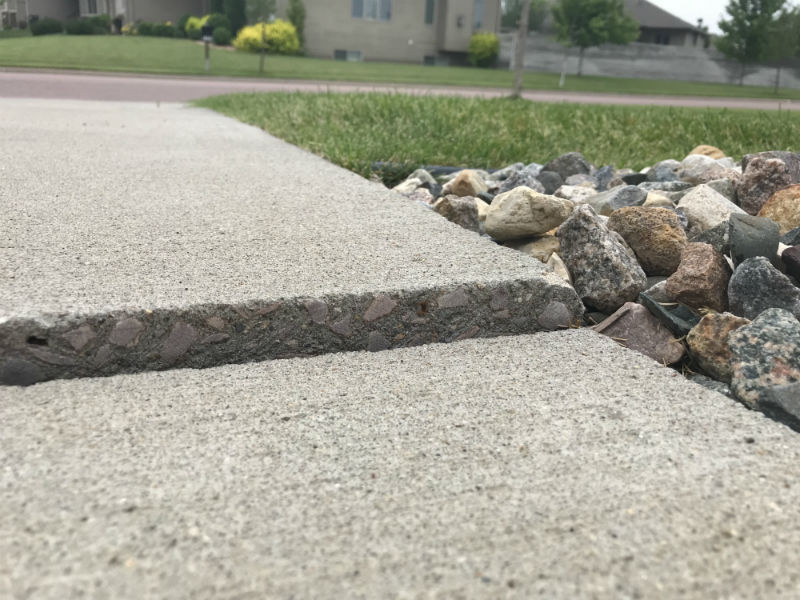
It’s quite common for homeowners to postpone concrete lifting repairs until the spring or summer. Unfortunately, this can lead to complications that result in further damage that requires more expensive repairs.
Whether it’s icy conditions in the winter, broiling temperatures in the summer or rainy weather in the spring, it seems that every season can complicate concrete repair. With that said, most of these issues are absent during the fall, when milder conditions promote an ideal work environment.
Many people are surprised to learn that autumn is actually an optimal time to schedule a concrete leveling project. According to Trevor Gaines of AAA Concrete Raising, much of this has to do with the changing climate.
“The fall climate provides a great work environment because it’s more stable and predictable,” he said. “There is less humidity in the air, the days are still warm and the nights are much cooler. Resurfacing concrete is complicated by hot temperatures. Many times, the overlay will dry too fast, causing brittleness and cracking. If the temperature is too cold, on the other hand, the water in the concrete mix will often freeze, causing the resurfacing material to break and crack into pieces.”
While possible, concrete leveling can be complicated by winter weather. Frozen ground can seriously inhibit slab jacking projects, which utilize hydraulic pressure to pump a slurry of water and sand. When contractors use the process in frigid temperatures, the material can sometimes freeze and make pumping impossible.
Even when this doesn’t occur, it can be difficult to clean up residual mud. When they introduce water for cleanup, contractors can inadvertently cause washout, intrusion or something called mud blow-out, where gooey deposits of the slurry accumulate and settle on top of the repaired concrete surface. Unless the process is performed using extra precautions, the concrete surface might not hold up after the spring thaw.
This is why it’s so important to go with an experienced contractor who knows how to guard against climate-related problems.
“Experienced contractors know how to avoid common problems associated with leveling concrete during less-than-ideal conditions,” said Gaines. “If they believe the project comes with a risk of failure, they will explain this to the customer and postpone the job until conditions are more favorable. They can also take precautions to keep climate-related complications from occurring. Unfortunately, less-experienced contractors are far too eager to do a job fast without much regard for the risks that come with both cold and hot weather.”
According to Gaines, it’s important for homeowners to ask questions before they hire a contractor to level their concrete.
“It’s good to ask potential contractors exactly how long they’ve been in business,” he said. “They should also ask to see examples of their past work. Most reputable local concrete contractors will have, on their websites or social platforms, a comprehensive portfolio of previous jobs. If not, it’s likely a sign they don’t have nearly as much experience as they claim.”
While an experienced contractor can drastically reduce the risk of weather-related complications, it’s still generally best to plan your leveling project before cold temperatures set in.
“Harsh winter conditions can worsen sunken concrete issues,” said Gaines. “As the underlying soil freezes and then thaws, cracked slabs can heave and buckle in response to movement of the underlying soil. If you wait until spring to raise your settled concrete, any existing problems could grow into a serious issue, requiring a much more expensive solution.”
Fall is also a good time to repair fractured concrete because reputable contractors tend to have greater availability, and material costs are often lower. It also allows homeowners to make their properties safer for winter foot traffic and ensures that exterior surfaces are ready for spring and summer activities.
Established in 1988, AAA Concrete Raising has served homeowners and businesses in the Denver metro area for more than three decades. Our skilled experts specialize in supporting and filling voids beneath concrete slabs, ensuring a functional, safe concrete surface while avoiding the need for complete slab replacement.
Our innovative and experienced concrete raising company uses leading-edge equipment which eliminates the need for awkward, disruptive and noisy machinery. Leveraging our impressive experience and expertise, we use the best materials to ensure a fast, efficient job, each and every time.